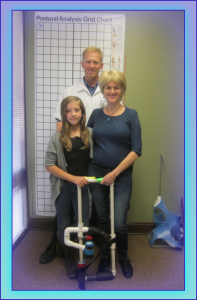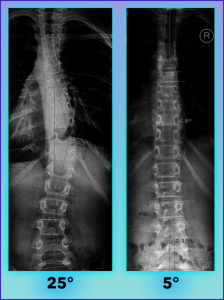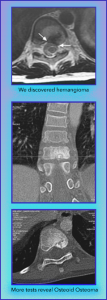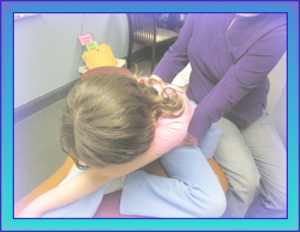Rachel’s Scoliosis Success Story
Scoliosis – Primary right thoracic with developing left lumbar
Meet Rachel
Rachel’s scoliosis story began when she was just 9 years old. She was out snow skiing with her family and crashed in the snow. Her back hurt a little, but didn’t really give her too many problems until 6 months later when she was trying to pick something up and her back started to hurt to the point that she was crying.
How She Discovered Her Scoliosis
She went to the chiropractor who did some adjustments to her back, and she started to feel better. However, weeks later, the pain returned. At this point, her parents took her to an orthopedist, who did a set of x-rays. The doctor informed them that Rachel had a fracture in her L5, most likely from the ski crash 6 months ago. It was probably getting worse and causing a Spondylolisthesis (slipped vertebra). The orthopedist recommended a back brace to try and get the fracture to heal. He ended the consultation with, “Oh, and by the way, Rachel has scoliosis. The three curves are only 6, 8, and 6 degrees, so don’t worry about it.” (Wait and See approach…very passive and very dangerous!)
Braces Were Not Enough. Scoliosis Was Progressing Rapidly.
Rachel wore the brace diligently for 3 months. Her pain improved and the fracture healed. However, the post-x-ray also showed that the scoliosis had gotten worse and was now 16, 22, and 18 degrees. Her core muscles were getting weak from the immobilization, and the scoliosis was progressing rapidly and needed to be stopped. Rachel was only 10 years old now, and a curve progressing at this pace could be in the surgical range in the next year or two. At this point, the Orthopedist recommended another brace to be worn for 23 hours a day for another year for her scoliosis.
Discovered Scoliosis Care Centers
Rachel’s parents wanted to find a different solution, though. They felt that the weakness was contributing to the progression of the scoliosis, so they went online and started looking for other conservative treatments for scoliosis. This is when they came across the YouTube video of Kaylee and her scoliosis story. The next month, Rachel was signed up for her 2-Week Intensive Scoliosis Treatment Camp at Janzen & Janzen Health Center.
She Discovered The Root of Her Scoliosis Problem
Upon examination, the Spinal Meningeal Tension Test was performed on Rachel. This is a test that can detect spinal cord or dural tension in a scoliotic patient. Rachel’s test was positive, but she had an atypically localized point of pain when the test was performed. Often the pain is more generalized throughout the spine, but Rachel’s pain was specific to T9—and when she would perform the test her spine would stop suddenly and she would feel pinpoint tugging and pain. This caused Dr. Janzen to conclude that there must be a specific adherence of the dura or cord at the T9 level.
An MRI of the spine was performed. The medical radiologist and the referring orthopedist found it to be “normal”
MRI Discovered Hemangioma But…
An MRI of the spine was performed. The medical radiologist and the referring orthopedist found it to be “normal.” However, our years of experience have taught us to always check the images ourselves. It’s shocking how often critical details are left out of a radiology report or are failed to be recognized by the referring doctor. Dr. Janzen personally examined the MRI images. Looking right at T9, there was a signal intensity consistent with what might be a hemangioma. The “signal” was largely in the vertebra, but extending into the spinal canal, where Dr. Janzen believed an “adherence” of the dura would be found.
More detailed tests reveal Osteoid Osteoma
Hemangiomas aren’t supposed to cause scoliosis. So, another test was performed, this time a 3-dimensional bone scan, and even better detail of the lesion within the bone and canal could be viewed. The diagnosis was certain now: an Osteoid Osteoma. This is a benign type of cyst, that can cause pain. They are typically not dangerous. But this Osteoid Osteoma was binding the dural lining of the meninges, placing a tug on Rachel’s spinal canal, causing the spine and all the vertebra to “coil down” around the tight spinal canal.
Now Rachel finally had a diagnosis. It was no longer “idiopathic” scoliosis (remember, idiopathic is the word “idiot” next to “pathic”—and it means we are too ignorant or stupid to understand why the problem is there). Now Rachel’s diagnosis was: 27 degree scoliosis due to spinal-meningeal tension from an Osteoid Osteoma at T9. (This is how ALL scoliosis SHOULD be diagnosed—by finding the root cause of the problem.)
It’s shocking how often critical details are left out of a radiology report, or are failed to be recognized by the referring doctor
Initiated Her First Step: Spinal Weighting
After taking the prior L5 fracture into account, the benign tumor, and Rachel’s weak core muscles, Janzen & Janzen initiated the first set of Spinal Weighting treatment protocols to get her core muscles stabilized and the Scoliosis Flexibility Trainer (SFT) to start creating some flexibility in the spine. Rachel was diligent with the program for the next 3 months.
Her Core Muscles Strengthened Significantly
At her 3 months follow up at Janzen & Janzen, the curve had continued to progress up to 25 degrees. It might seem like bad news, but the positive was that Rachel’s core muscles had strengthened significantly and her spine was much more flexible. This gave Janzen and Janzen more to work with. They “tweaked” the Spinal Weighting and advanced her program to be even more aggressive. They also developed some targeted stretches to go after the dural tension and kink at T9 where the tumor was. Rachel, again, diligently performed the Scoliosis Treatment Program—SFT two times a day and Spinal Weighting three times a day. In fact, her parents brought the Scoliosis Flexibility Trainer and Spinal Weighting to Disneyland and set it up in the hotel. When they went back to Lake Tahoe to go skiing…they brought the SFT and Spinal Weighting.
Her Curve Went Down To 4 Degrees
Rachel went in for her follow-ups every 3 months. Visually and upon exam, the spine was looking better. No x-rays were needed. More advancements were made and Rachel continued the program. For 18 months, Rachel stayed diligent. Janzen & Janzen decided to take an x-ray at this point. The curve had reduced from 18, 25, and 20 degrees to 6, 8, and 6 degrees for the 3 curves. Rachel’s program was changed again. She was now able to drop the SFT completely and the Spinal Weighting was modified to go after her new smaller curves. Rachel, again, was diligent with the new program. After another 3 months, Rachel’s curves went down to 9, 4, and 1 degrees.
When Rachel’s parents took her back to her orthopedist to show him the results, his response was, “Oh well, I guess I don’t need to see you anymore.” That was it!
Had Rachel done “nothing,” or remained in a brace-only treatment, she could very well, at age 12, be looking at surgery right now. The hard work paid off. Rachel and her parents mentioned many times that the program was no “cake walk.” In fact it was very trying at times. But at the end of the day, Rachel and her parents are obviously glad they made the right decision to help their daughter.




